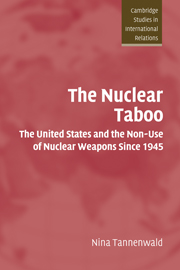Book contents
- Frontmatter
- Contents
- Preface
- List of abbreviations
- 1 Introduction: the tradition of nuclear non-use
- 2 Explaining non-use
- 3 Hiroshima and the origins of the nuclear taboo
- 4 The Korean War: the emerging taboo
- 5 The rise of the nuclear taboo, 1953–1960
- 6 Nuclear weapons and the Vietnam War
- 7 Institutionalizing the taboo, 1960–1989
- 8 The 1991 Gulf War
- 9 The taboo in the post-Cold War world
- 10 Conclusion: the prospects for the nuclear taboo
- Select bibliography
- Index
- CAMBRIDGE STUDIES IN INTERNATIONAL RELATIONS
6 - Nuclear weapons and the Vietnam War
Published online by Cambridge University Press: 22 September 2009
- Frontmatter
- Contents
- Preface
- List of abbreviations
- 1 Introduction: the tradition of nuclear non-use
- 2 Explaining non-use
- 3 Hiroshima and the origins of the nuclear taboo
- 4 The Korean War: the emerging taboo
- 5 The rise of the nuclear taboo, 1953–1960
- 6 Nuclear weapons and the Vietnam War
- 7 Institutionalizing the taboo, 1960–1989
- 8 The 1991 Gulf War
- 9 The taboo in the post-Cold War world
- 10 Conclusion: the prospects for the nuclear taboo
- Select bibliography
- Index
- CAMBRIDGE STUDIES IN INTERNATIONAL RELATIONS
Summary
Never had the military gap between a superpower and a non-nuclear state been greater; never was it less likely to be invoked.
Henry Kissinger, 1994Of all cases of Cold War conflict in which the United States could have used nuclear weapons, the Vietnam War provides one of the strongest “tests” of a nuclear taboo. In Vietnam, the United States chose to lose a humiliating and destructive war against a small, non-nuclear adversary while all its nuclear weapons remained on the shelf. During the ten-year military commitment to South Vietnam in the 1960s and 1970s, the United States sustained large losses in men, money, and materiel at tremendous political cost. US officials repeatedly declared that the United States could not tolerate the loss of Southeast Asia to Communism, and that the war was vital for US interests, prestige, and security.
As the war escalated, the United States was willing to maintain policies of great destructiveness. Operation Rolling Thunder, begun in March 1965, continued for three years and dropped more bombs on Vietnam than were dropped on all of Europe in World War II. Starting in 1969, B-52 raids demolished vast areas in North and South Vietnam, Cambodia, and Laos. US forces employed herbicides and defoliants to obliterate croplands and forests, dropped flame throwers and napalm, and eventually mined Haiphong harbor. It is estimated that some 3.6 million Vietnamese in both North and South, were killed in the conflict, and 58,000 Americans.
- Type
- Chapter
- Information
- The Nuclear TabooThe United States and the Non-Use of Nuclear Weapons Since 1945, pp. 190 - 240Publisher: Cambridge University PressPrint publication year: 2007

